Hotels have a range of pricing strategies to drive revenue, and setting the right room rates is crucial—not just to boost occupancy but to maximize profit. The goal is to find that pricing sweet spot that fills as many rooms as possible while optimizing overall profitability.
Maximizing revenue is a priority for any hotel. By using the right pricing strategy, one that considers demand, customer segments, and other key factors we’ll discuss, hotels can confidently work toward this goal. In this article, we’ll cover what a hotel room pricing strategy is, why it matters, and the 20 most effective strategies to increase revenue.
Table of contents
What is a hotel room pricing strategy and why is it important in the hotel industry?
A hotel room pricing strategy is an important part of hotel revenue management. It is essentially the rate you charge per hotel room in an effort to sell as many rooms as possible and gain maximum room revenue. It’s that balance between charging enough so that you make money and charging a fair price so that you don’t lose customers to the competition.
This strategy is vital in the hotel industry because it directly impacts your ability to sell rooms, boost occupancy and profitability. If your rates are too low, you risk losing money and struggling to cover operational costs. If they’re too high, you risk potential customers choosing the competition. It’s not an easy task and that’s why we’ll talk about the factors to keep in mind, plus 20 strategies that can help make the task easier.

How does hotel pricing work?
Hotel pricing is a balancing act that takes into consideration many different factors like fluctuations in demand, competitor pricing, guest reviews, operational costs and profit margins. Essentially, it operates on the principles of supply and demand – when demand rises, so do hotel prices, and when supply outweighs demand, prices drop.
Hotel pricing is not linear. By taking into account all of these factors, hoteliers have the best shot at achieving optimal occupancy and revenue. This process can be significantly streamlined with the help of technology – and specifically, automation. You can also automate pricing with an AI-powered revenue management system (RMS) like Atomize, a Mews company, which continuously analyzes real-time data and market conditions to recommend or apply the most profitable rates. This ensures hotels can stay competitive without the need for constant manual adjustments.
What factors should you consider when implementing a hotel pricing strategy?
When implementing a hotel pricing strategy, there are several important factors to keep in mind. First and foremost, be mindful of the supply and demand in your local market. It’s crucial to ensure your prices are competitive, avoiding rates that are significantly higher or lower than the market average.
Another factor hoteliers should also consider is the types of rooms available and the value of the services they offer. Offering a range of room prices can help you cater to different guest segments and meet various targets. Additionally, keep an eye on your competitors’ prices, your current occupancy levels, seasonality, and even the day of the week.
The 20 most effective hotel pricing strategies to increase revenue
Now that you know the key factors behind implementing a pricing strategy, let’s take a look at the 20 most effective pricing strategies in the hotel industry.
1. Competitor-based
There is no better indicator of how well you’re doing or the market trends than by looking at the competition. The competition affords powerful insights and ideas not only about how you can improve but also pricing strategies you can implement yourself. It’s important to look at your direct competition, that is the same segment and star category.
A competitor-based hotel room rate pricing strategy starts by understanding the rates your competitors are selling their rooms at. See how they set their rates for each room category, when they are increasing or decreasing their room rates, and how often they offer discounts. Then compare your rates with their rates in order to understand what customers are already paying and how much they are willing to pay. This is a useful way of deciding what price to charge.
2. Forecasting-based
Forecasting is an effective strategy to set prices based on what you expect the demand to be. This expectation relies on understanding your hotel’s occupancy data, revenue, room rate and average spend per room for the last couple of months and in the same period the previous year, as well as looking at demand and events. It is one of the most important strategies for hotels.
By understanding what occupancy could potentially be based on historical data, you can then modify the hotel room price by forecasting the number of rooms that will be available in the future.
If you do it right, you’ll be able to predict the best prices based on demand and expected occupancy. It’s also important to keep in mind whether your hotel is in a trending destination or if the competitors have increased or decreased when using this method.
3. Length-of stay
This way of setting prices is effective because it enables you to set a consistent rate for the entire duration of a guest’s stay, taking into account both the length of their stay and their arrival date. In order to use this strategy, you need to establish the correct price by looking at bookings you already have as well as forecasts to understand the demand.
For example, if there’s a festival or special event, you might set a minimum length of stay for the duration of the festival so that you are sure to lock in some bookings and ensure that you have an increased number of nights’ stay. The goal is to modify prices based on the minimum and maximum length of stay to increase occupancy and hopefully encourage longer stays.
4. Segment-based
This strategy is similar to the airline’s strategy, where you charge different prices to different people for the same room. This is one of the most commonly used pricing strategies in the hotel industry because it has a huge impact on a hotel’s bottom-line revenue.
Customers can be segmented by volume (booking more rooms at once), attributes (those wanting a sea view room vs a garden view), service offering, time of purchase, time used, or more. For example, you might charge corporate guests a lower price for the same room because they are more likely to book more rooms at any given time, whereas you might charge a walk-in guest who needs just one night’s stay a higher price because of the urgency of their booking.

5. Guest type-based
Guest-type based pricing is similar to segment-based, where you charge higher prices to different types of guests. In this type of price structure, guests can be categorized based on different factors, such as their preferences, the purpose of visit, age, class, location, or occupation.
You can take into consideration the booking trends of each type of guest and then adjust the pricing strategy accordingly to who brings you more quality business. This is an effective way of setting prices because it studies trends for each type of guest to accurately and effectively set prices.
6. Occupancy-based
An occupancy-based hotel pricing strategy is another very common way of setting prices because it’s one of the best ways of increasing room revenue. An occupancy-based strategy works based on supply and demand; essentially when demand exceeds supply, you increase your room rates. On the contrary in low season, in order to ensure revenue, you can charge lower prices in order to increase occupancy.
7. Incentive-based
An incentive-based pricing strategy is based on rewarding customers with better prices through discounts, promotions, and other package deals, thereby giving them an incentive to book. In order to implement this strategy, you can offer discount codes or promotions through email marketing and online marketing for your repeat guests, and thereby encourage them to book directly with your hotel, which provides more revenue per booking by taking out the middleman.
8. Loyalty-based
The loyalty-based pricing strategy is similar to the incentive method but is targeted at members of your loyalty program or encouraging people to join the loyalty program to get better prices. This is a useful and effective method to encourage not only direct bookings, but also to keep guests coming back. In this way, you can offer better prices to loyal customers, and loyal customers are likely to keep coming back, so it’s a win-win scenario.
9. Cancelation policy
A surprisingly effective way of increasing your revenue is the cancelation policy pricing strategy. Essentially, people pay a better price if they book at a non-refundable rate. In this way your hotel can sell rooms at a profitable price while at the same time cutting losses. That is to say, if a guest cancels, they won’t get a refund, so since you have already locked in revenue from the room, you can charge a lower rate to resell the room if it gets canceled. This is a particularly useful strategy during the high season.
10. Upselling
Upselling is a useful tool in any industry, but it is especially useful when setting hotel prices. You can give guests the option to upgrade to a better room, suite or a sea view or add in services at the time of booking which helps generate more revenue per booking. The idea is that once you have captured the client, you can encourage them to spend more.
11. Cross-selling
Similar to the upselling strategy, cross-selling is a useful strategy that is particularly effective after the booking is made. You can encourage clients to book additional services, such as spa services, tours and airport transfers, for example through email marketing and online campaigns. Just like upselling, cross-selling helps generate more revenue per booking.
12. Rate-parity strategy
The rate-parity strategy is an effective method that inspires trust in your clients as well as giving a sense of transparency. Essentially, you keep the rates for each product the same across all online distribution channels. While OTAs charge commission, so you won’t get the same revenue as with a direct booking, you can also implement one of the other room rate strategies listed above to encourage direct bookings.
13. Seasonality-based
A seasonal hotel pricing strategy begins with forecasting, predicting periods of high demand to raise prices and lowering them when demand is expected to be low. During the low season, hoteliers can boost bookings by offering promotional deals and packages to help increase bookings.
14. Psychological pricing
Psychological pricing involves setting prices just below a whole number. For example, instead of charging $150 per night, you set the price at $149. This small difference can make a significant impact, as guests are more likely to book at $149 due to psychological factors.
15. Package pricing
Package pricing involves creating deals that include more than just a room. These packages might bundle additional services, which not only boosts ancillary revenue but also allows you to charge a higher rate for the room within the package.
16. Weekend pricing
Weekend pricing means setting higher rates for Fridays and Saturdays, and sometimes Sundays, although many hotels lower rates by Sunday night. This strategy is particularly useful if your hotel is in an area popular for weekend visits.
17. Group pricing
Group pricing offers discounted rates for reservations above a certain number of people. This practice is mutually beneficial as it helps you reach your ideal occupancy level more easily and simplifies management by dealing with one group leader instead of multiple individuals.
18. Cost-plus pricing
Cost-plus pricing involves calculating your fixed and variable costs and then adding a profit margin on top to determine your room rates.
19. Open pricing
Open pricing allows hoteliers to customize rates across different distribution channels, room categories, and specific dates. This approach requires frequent monitoring and adjustments but offers more precise pricing.
20. Market-based
Market-based pricing sets room rates based on market conditions and competitor pricing. This strategy helps you stay competitive by offering better rates or positioning your hotel based on its unique value proposition.

Enhance your pricing strategy with Mews and Atomize
To truly maximize revenue, hotels need more than just a solid pricing strategy – they need the right tools to execute it efficiently and intelligently. That’s where Mews and Atomize come in. Together, these powerful platforms offer a seamless, automated solution for optimizing your hotel’s pricing in real time.
Mews provides the foundation for smart pricing decisions with its robust automation, real-time data access and seamless integration capabilities. You can easily apply dynamic pricing strategies across all channels, ensuring rate parity while reducing manual workload.
Complementing Mews, Atomize is an intelligent revenue management system (RMS) that leverages machine learning and real-time market data to deliver fully automated pricing recommendations around the clock. Atomize analyzes a wide range of variables – such as demand forecasts, booking pace and competitor rates – to continuously adjust room prices with surgical precision. Its intuitive interface allows hoteliers to monitor performance and react instantly to market shifts, making it easier to stay competitive and maximize RevPAR.
When integrated, Mews and Atomize form a powerful tech stack that empowers hotels to make smarter, faster and more profitable pricing decisions. This dynamic duo enables properties of all sizes to confidently implement advanced pricing strategies, increase direct bookings and drive sustainable revenue growth – all with minimal manual effort.
Need some inspiration on how to achieve pricing excellence? Join Matt Welle and Alexander Edström, founder of Atomize RMS (a Mews Company), as they dive into the art of revenue optimization in this insightful chat.
How can you determine which strategy is the best for your property?
There is no one-size-fits-all approach to pricing. It’s essential to test different strategies and understand which one works best for your property. The optimal strategy often depends on factors such as your hotel’s location, size, target profile, competition, and unique value proposition.
For instance, if your hotel is in an area with little competition, competitor-based pricing might not be the best choice. Conversely, if your location attracts many weekend visitors, such as being an hour from a major city by the sea or in the mountains, weekend-based pricing could be ideal.
Seasonality pricing is another consideration. If your hotel’s unique value proposition is its proximity to a hot spring, package-based or incentive-based pricing might be effective, allowing you to create thematic packages around this unique feature.
For larger resorts, a group pricing strategy makes sense, as you are likely to attract family groups and groups of friends. However, for a small bed and breakfast with only five rooms, group-based pricing wouldn’t be practical.
Ultimately, it’s important to consider all these factors and experiment with different pricing strategies to find what works best for your property.
Hotel pricing compliance
Especially when using dynamic rates, make sure that your room rates and charges are consistent across channels to maintain your reputation. This means offering the same rates across different OTAs (Online Travel Agencies) to stay compliant and maintain credibility.
Pricing compliance also involves transparency—no hidden fees or surprise charges. What the guest pays should match their expectations. Additionally, when launching promotional deals, clearly specify the conditions, including blackout dates and cancellation policies. Compliance standards may vary depending on your hotel’s location, but it’s vital to always adhere to the relevant rules and regulations.
Conclusion
As we’ve explored, there are numerous strategies to optimize pricing and maximize your hotel’s revenue. To achieve this, it’s essential to consider various factors such as supply and demand, time of year, different guest segments, and competitor pricing, among others discussed throughout this article.
Different pricing methods can be applied simultaneously or at different times of the year. Successfully implementing the best pricing strategies is undoubtedly one of the most crucial steps you can take to increase revenue in the hotel industry.
Getting the right payment solution

Your pricing strategy is part of a wider conversation about payments, and that's a conversation that we need to have. Hospitality has been slow in comparison to other industries when it comes to adopting modern payment methods, but things are finally starting to change.
Want to know what you can do to embrace modern payments? Download our guide, We Need to Talk about Payments.

2026 Hospitality Industry Outlook
Download now
Table of contents
Hospitality hot takes straight to your inbox



.webp)
